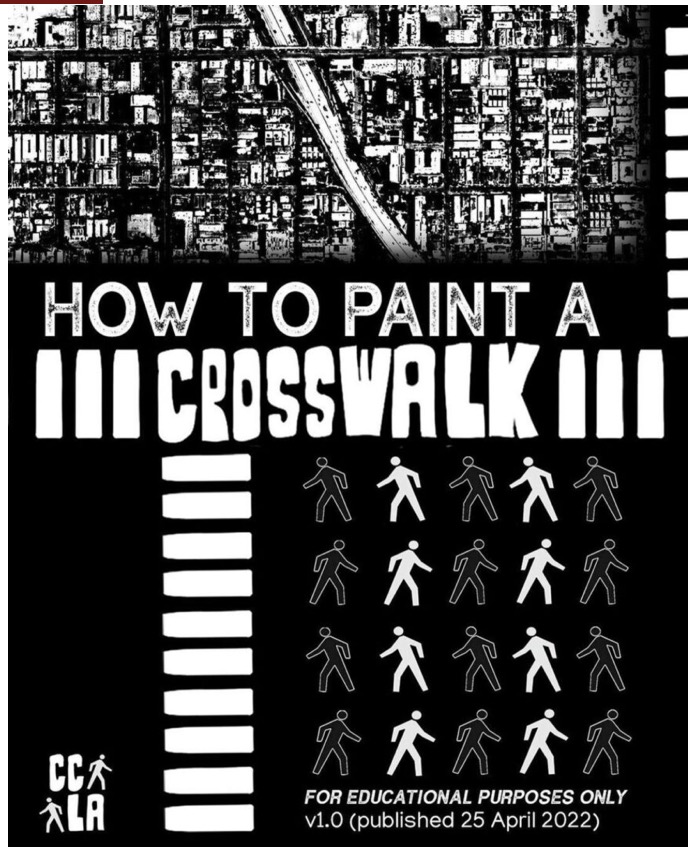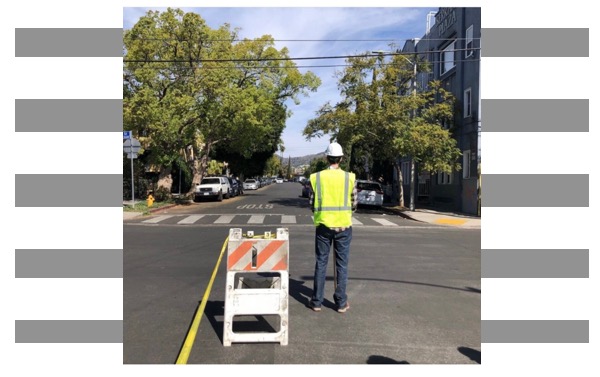CommentsCROSSWALK SAFETY - The first rogue crosswalk appeared at the intersection of Romaine Avenue and Serrano Street in East Hollywood in April.
A few weeks later, another quietly appeared at San Marino Street and South Serrano Avenue in Koreatown. The crosswalks aren’t the work of city employees, but the work of a group of Angelenos who are fed up with the city’s efforts to improve pedestrian safety.
The Crosswalk Collective (CCLA) is an activist group that paints crosswalks in neighborhoods with high concentrations of traffic accidents, mainly after receiving requests from community members.
A safety study by the LA Department of Transportation (LADOT) found that someone walking or riding a bicycle was 16 times more likely to be killed in an accident than someone driving a car. That analysis led LADOT to implement a High-Injury Network, which represents 6% of LA streets that account for 70% of deaths or severe injuries for people walking.
CCLA was officially formed in 2022, but they say they’ve been working to improve pedestrian infrastructure for much longer. In April, the group published a guide for Angelenos who want to paint their own crosswalks.
“We had been advocating for crosswalks and safe streets infrastructure through official channels for years, and very little ever happened,” a representative for CCLA told Knock LA. “In fact, we spent as much time fighting to keep the city from removing the few safety improvements we’d gotten approval for as we did fighting for new ones.”
CCLA’s crosswalk improvement is an example of insurgent planning, a concept in urban design that describes when community members who have seen inaction from local government bodies take those actions themselves.

A before-and-after image of the intersection at Romaine Avenue and Serrano Street in East Hollywood after CCLA’s work. (@crosswalksla | Instagram)
“Prioritizing the automobile over the pedestrian route can qualify as not just inaction, but quite frankly, violent inaction,” said CSUN professor of urban studies Brettany Shannon. “Insurgent planning is the community’s response to that continued stagnation.”
Even with the efforts of victims and advocacy groups, the process of getting the city to address the need for a crosswalk, a speed bump, or even to repair a broken sidewalk is filled with red tape and dead ends. There is a backlog of sidewalk repair requests so large that the city doesn’t know how many are still unfulfilled.
“In Los Angeles, a speed bump can take you over a year to secure,” said John Yi, CEO of Los Angeles Walks, an organization that advocates for pedestrian-friendly infrastructure in BIPOC neighborhoods.
On April 12, an LADOT representative saw four members of the group painting another crosswalk in Koreatown and called the LAPD. Each person present was fined $250 and cited by the LAPD for “injury to public property.”
“Unauthorized alterations to the street are illegal and subject to removal,” said a representative from LADOT. The representative also said there is no history of fatal collisions at this location and that LADOT has not received requests to install a crosswalk at this location.
In late May, the crosswalks CCLA painted in Koreatown were painted over by LADOT workers. Residents were promised a “traffic circle,” which is a roundabout with crosswalks at each junction. LADOT did not provide CCLA with a timeline of construction.
The intersection of Romaine Avenue and Serrano Street, just blocks from LA City College and three elementary schools, has recorded five traffic deaths since 2010. It’s in the middle of two High-Injury Network streets, but the intersection itself isn’t considered a part of that group.
Though Mayor Eric Garcetti launched Vision Zero in 2015 to eliminate traffic deaths on LA’s streets by 2025, Councilmember Paul Koretz moved a motion to audit the program in March 2022 after LAPD data showed 289 people were killed in traffic collisions in 2021.
Other Angelenos have tried painting their own crosswalk, like Atwater Village resident Sean Meredith and his friend who painted a crosswalk on the Hyperion Bridge. That too was painted over.
Glendale Boulevard and Glenhurst Avenue, the only intersection near the bridge with a crosswalk, has recorded nearly 30 traffic collisions since 2010. You can still see the remnants of the crosswalk Meredith painted on Google Maps.
The nearly 140 crosswalk requests sent to CCLA detail how crosswalks won’t be installed for several months or years, despite fatal traffic accidents occurring at the same intersection.

Crosswalk Collective’s guide to DIY crosswalk painting (@crosswalksla | Instagram)
“I often see mothers with children and seniors trying to cross the street from their homes to the park with great difficulty because of the steady stream of traffic and speeding cars,” one sidewalk request reads.
In June, Gardner Street Elementary School in Hollywood requested a crosswalk from CCLA after multiple requests to the city were ignored.
“Every day we watch as students and parents dart across the street, frantically trying not to be late for school, while at the same time, cars blaze through those stop signs,” said Katie Pace, a parent at Gardner. Earlier this year, Pace’s car door was torn off by another car speeding down Hawthorne Avenue.
“While it shook me, it made me increasingly more concerned that someone, especially a child, was going to be killed there,” Pace said. Pace sent a request to CCLA after reading about the group in an NPR article. Although crosswalks were placed by the city at another intersection near the school, according to Pace, it wasn’t enough to protect students walking to and from school.
Pace hopes that the crosswalk CCLA painted will be a helpful step towards protecting students and, maybe one day, getting another official crosswalk to make the school safer.
“I think sometimes we have to break the rules a little bit to make big things happen,” Pace said. “I think only good can come from breaking this one.”
According to CCLA, the city rarely displays an urgency to act, even after people are seriously hurt or killed.
“The implication from the city was always, ‘Come back to us when enough people have died or been injured,’” said a representative from CCLA. “Every time someone got hurt or died, we knew to jump on it to get the safety improvements we’d been asking for, and even then the city wouldn’t always do it.”
If members of CCLA are caught painting a crosswalk again, each person present will be fined $1,000. Still, the activists will continue advocating for safer streets, and painting more crosswalks.
“Painting crosswalks also means that it is us — residents and community members — who are taking charge of our own safety,” CCLA said. “Doing has transformative power: It connects us to our neighbors, it gives us an active role in shaping our communities, it helps us heal.”
(Emily Holshouser is an author and writer for KNOCK LA where this article was first featured.)






